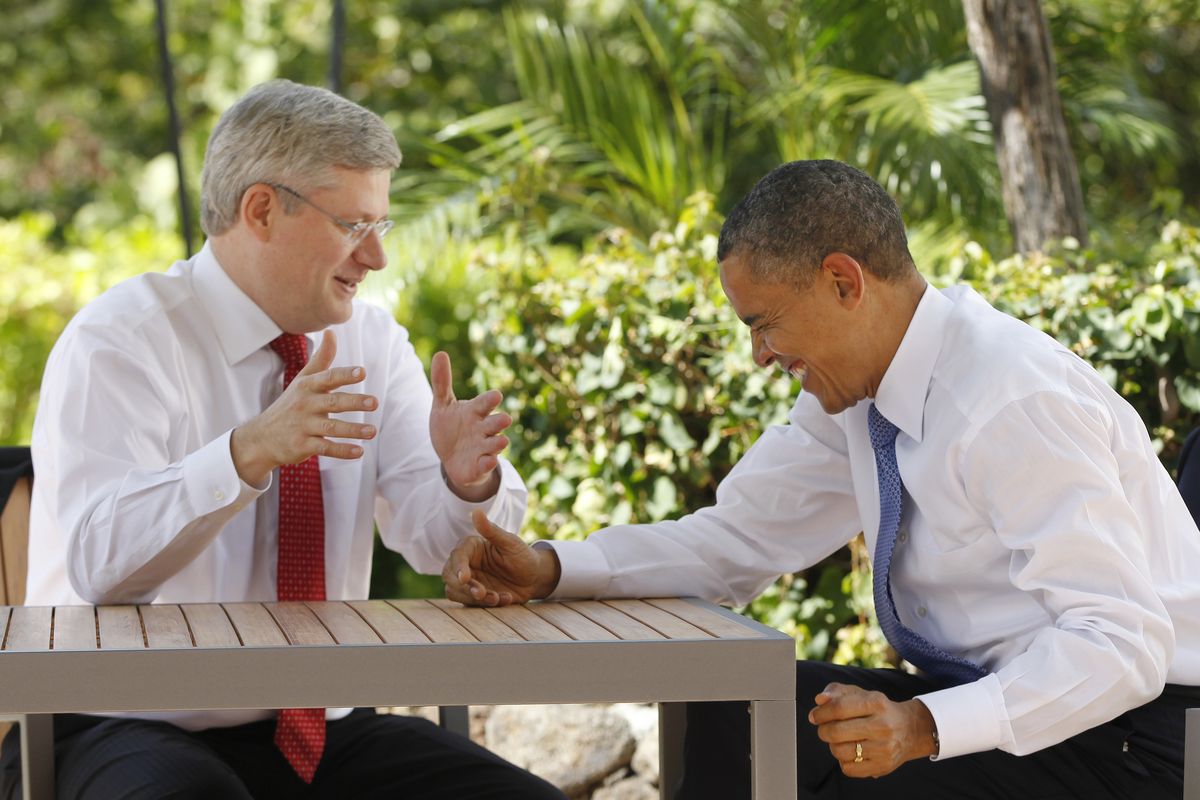Pacific trade pact gets boost
Canada, Mexico offer support for Obama-led proposal; China still reluctant

KAPOLEI, Hawaii – A U.S.-backed plan to forge a Pacific free trade bloc got a big boost Sunday when leaders of Canada and Mexico joined Japan in expressing support for a deal that has received a cool reception from China, the region’s rising power.
The news was a coup for President Barack Obama, who made progress on the pact one of his top priorities for the Asia-Pacific Economic Cooperation summit being held in his home state of Hawaii. It comes after Japan, the world’s third-biggest economy, said Friday that it wants to join the nine nations already involved in talks on what has been dubbed the Trans-Pacific Partnership.
The balmy weather for the annual APEC gathering at a resort on the Hawaiian island of Oahu contrasted with deepening pessimism over the economic outlook as the leaders sat down for a day of talks on how to spur growth and create jobs. With Europe again on the brink of recession, Asia’s vital role as a driver of global growth has gained even greater urgency.
International Monetary Fund Director Christine Lagarde attended the summit, briefing the APEC leaders on the latest developments in Europe. The IMF will play a key role in coming months in overseeing efforts by Italy, and other ailing economies that use the euro common currency, to rein in debt.
Europe’s quandary is among the wide range of issues that the Asia-Pacific leaders were tackling in their one-day meeting.
“Now it’s time to get down to work, and we have much to do,” Obama said in opening the summit. “Our 21 economies – our nearly 3 billion citizens – are looking to us to bring our economies closer, to increase exports, to expand trade and opportunity that creates jobs and economic growth. That’s why we’re here.”
Canadian Prime Minister Stephen Harper said his country must look to the East to ensure markets, especially for its energy exports. “That will be an important priority of this government going forward,” Harper said.
U.S. Trade Representative Ron Kirk welcomed the overtures from Canada and Mexico about joining the so-called TPP, issuing a statement calling them America’s “neighbors and largest export markets.”
But China, which some economists say is on course to overtake the U.S. as the world’s biggest economy this decade, has appeared reluctant to endorse the Pacific trade pact, likely wary of being drawn into what has become a U.S.-led initiative that encroaches on its own sphere of influence in Asia. China also has commitments to rival free trade blocs in East and Southeast Asia.
The TPP group now includes only four smaller, relatively affluent economies – Chile, New Zealand, Brunei and Singapore – but the U.S., Australia, Malaysia, Vietnam and Peru are negotiating to join.
U.S. officials have said all are welcome to come on board, while indicating that the agreement’s high standards would pose a challenge to countries whose economies are not fully open. That would likely include Russia, which is close to gaining long-sought membership of the World Trade Organization, and China, which has staked out large sections of its economy for protection from foreign competition.
Obama has said he is optimistic that work on the American-backed trade pact could result in a legal framework by next year.
For the U.S., the initiative is seen as a way to break through bottlenecks and open new business opportunities. Many in APEC see the emerging deal as a building block for a free trade area that eventually encompasses all of Asia and the Pacific – covering half the world’s commerce and two-fifths of its trade.
“The Asia Pacific region is absolutely critical to America’s economic growth. We consider it a top priority. And we consider it a top priority because we’re not going to be able to put our folks back to work and grow our economy and expand opportunity unless the Asia Pacific region is also successful,” Obama told his fellow APEC leaders at Sunday’s meeting.
Thomas Donohue, president of the U.S. Chamber of Commerce, an influential business lobbying group, praised the Pacific trade initiative.
“An important step to unlocking global economic growth will be expanding trade in the Asia-Pacific, and the TPP holds this key,” Donohue said. He urged the group to move quickly in drawing up a timeline that is “comprehensive, enforceable, and makes room for new entrants.”
The United Steelworkers Union also welcomed news of progress on the trade pact.
“The USW appreciates the administration’s aggressive outreach on ways that the TPP could support manufacturing and create jobs in the U.S.,” the labor union said in a statement.
APEC joins 21 economies, both huge and tiny, rich and poor. As always, the divergence between rich and developing economies – and between the U.S. and China – was apparent.
In Hawaii, Obama was also pushing hard on trade issues with China.
Before a meeting with Chinese President Hu Jintao on Saturday, Obama exhorted Beijing to “play by the rules,” citing controls that keep China’s currency undervalued as one example. He also cited lax enforcement of protection of intellectual property rights, favoritism toward state-run enterprises and other issues that have long dogged trade relations between the world’s two leading economies.
The APEC leaders began their summit still not agreed on terms for freer trade in environmental goods and services, another of Obama’s priorities for the annual gathering.
Speaking Saturday ahead of a meeting with Obama, Hu reiterated the Chinese government’s insistence that APEC respect the choices made by its members “to independently pursue green growth on the basis of their resource endowment, stage of development and capacity.”
APEC’s lack of negotiating power – all decisions are by consensus – means prospects for major, immediate changes are slim, though over time its incremental efforts have helped build support for closer economic ties and freer trade.